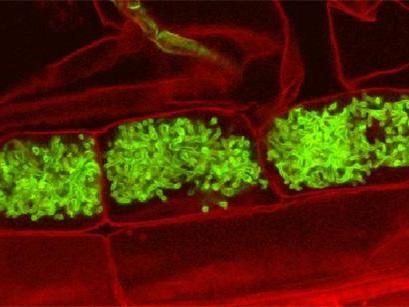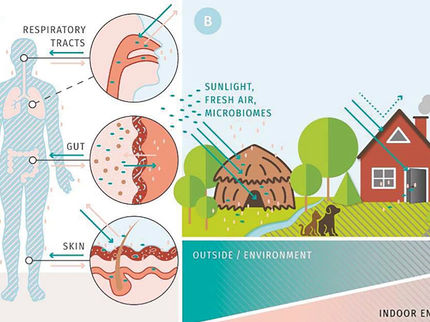Feeding fat to fungi: Evidence for lipid transfer in arbuscular mycorrhiza
Nearly all organisms live in symbiosis with a vast, diverse array of microbes. Arbuscular mycorrhizal (AM) symbiosis is the interaction between plants and a group of fungi called Glomeromycota. Most land plants, including several crop species, are able to interact with these fungi, which have been long known to positively affect plant growth and nutrition. The fungi live in plant roots where they elongate their tendrils (called hypha) into the surrounding soil, like an extension of the root system, to better access and transfer nutrients to the plant. In return the plant serves the fungus food made during photosynthesis.

Confocal microscopy image of fungal arbuscules (green) inside plant root cells (red).
Dr. Maria J. Harrison, BTI
Previous research has shown that an AM fungal dinner at least consists of high-energy sugars researchers from the labs of Dr. Maria Harrison at the Boyce Thompson Institute and Dr. Peter Dörmann at the University of Bonn have produced the first experimental evidence to suggest that AM fungi also get their fat (lipids) from the host plant .
"Until recently, it has been assumed that the fungus obtains sugar from the plant and can manage to make other essential nutrients itself," Harrison explains. "However, this is not the full story."
The transfer of lipid may be just as important. Living inside a plant root, the fungus will enter the root cells and create a tree-like structure called an arbuscule, giving the symbiosis its namesake. As an arbuscule is formed, new plant and fungal membrane must be generated, like the bark on the extending branches of a growing tree. To do so both organisms ramp up production of lipids, which are important building blocks for cell membranes. Sure enough, plant root cells that harbor fungal arbuscules increase their expression of genes involved in producing such lipids by 3000-fold.
Taking it a step further, Bravo et al. showed that individually mutating two of those genes, FatM and RAM2, in the model legume Medicago truncatula not only disrupts the fungus' ability to form healthy arbuscules, but also reduces plant production of a lipid necessary for fungal growth, called 16:0 β-monoacylglycerol (MAG). This result indicates that FatM and RAM2 may play specific roles in the biosynthesis of 16:0 βMAG, and further highlights the importance of this particular lipid for AM symbiosis.
What makes this food exchange even more important is the fact that AM fungi can't synthesize 16:0 βMAG themselves, indicating the fungi depend on their host plant as the source of this molecule. The exciting discovery that the plant provides the fungus with this essential lipid helps explain the fungus' mysterious obligate nature, meaning it is completely dependent on its host for survival and reproduction.
"Without the basic lipids that are obtained from the plant, the AM fungus cannot produce the complex lipids that it requires to live," says first author Armando Bravo.
One of the next steps in this research is to investigate how the plant regulates 16:0 βMAG production, and whether more fat for the fungus means more nutrient transfer to the plant in return. In a world where agricultural lands are being depleted of essential nutrients, AM symbiosis may be the key to healthier plants and greater crop yield.




















































